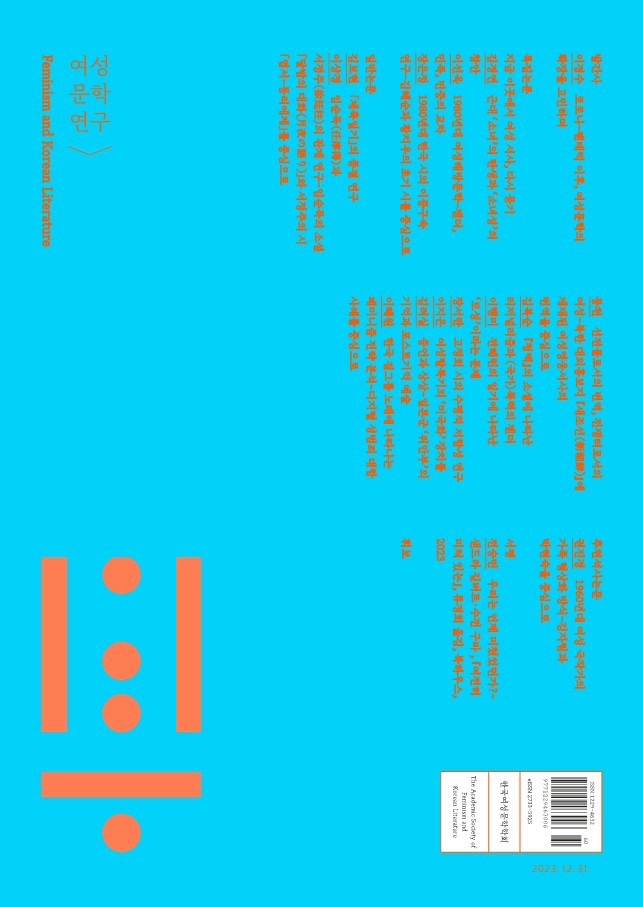- ENGLISH
- P-ISSN1229-4632
- E-ISSN2733-5925
- KCI
 ISSN : 1229-4632
ISSN : 1229-4632
아우구스트 베벨의 『여성과 사회주의』를 둘러싼 번역 실천과 젠더 역학
August Bebel’s Women and Socialism in Korea: Translation and Gender Dynamics
초록
동아시아에서 『부인론』이라는 제목으로 널리 알려진 아우구스트 베벨의 저서『여성과 사회주의』는 1879년 처음 나온 뒤로 수십 년 간 거듭 개정판이 발간되고 수십 개 언어로 번역된 사회주의의 고전이다. 한국에서는 1920년대 중반에공산주의자 배성룡과 아나키스트 신종석에 의해 각각 원저의 2부(현재의 여성) 와 1부(과거의 여성)가 차례로 발췌 번역된 이래, 1990년 최초의 완역본이 나오기까지 총 아홉 번의 번역 시도가 있었다. 이들은 번역의 저본이 되는 일역본 및중역본 그리고 영역본과 상호 텍스트적 관계를 갖는 한편, 완역의 형태를 갖지는못했으나 검열의 시대를 통과하며 수행된 그 나름의 번역 실천을 보여준다. 한편1920년대 초에서 30년대 초까지 이 책의 직접적인 영향 하에 쓰인 여러 파생 텍스트들을 확인할 수 있는데, 예외 없이 남성 사회주의자들에 의해 쓰인 이 글들은 일부일처제와 매음(매매혼) 문제에 특히 편중된 주제의식을 드러냈다. 무엇보다 이들은 여성 혐오와 시혜적인 입장을 노출하기도 하는 등 조선 여성이 처한 구조적 문제 및 자본주의 하의 젠더 모순에 육박하지는 못했다. 이 책이 당대의 여성 독자들 및 여성 지식인들에게 해방의 교과서처럼 거론되었음에도 실제로 진지한 접근이나 해방 담론이 충분히 펼쳐지지 못했던 것은 조선 여성이 처한열악한 상황을 되비쳐주고 있다. 일본의 선구적 여성 사회주의자로 동아시아에서 『부인론』을 처음 완역한 야마카와 기쿠에가 조선 여성에게 내민 연대의 손길조차도 일본 무산계급 운동에 조선여성이 포섭되는 방식으로만 승리(해방)가 가능하다는 역설을 보여준다. 그럼에도 불구하고 백 년 전에 이루어진 불완전한 번역 실천과 연대의 시도들은 현재까지도 물음을 그치지 않아야 하는 문제들을 환기하고 있다는 점에서 의미가 있다.
- keywords
- Socialism, Theories of Women’s Liberation, translation practice, censorship, Buin-ron(On Women), Bae Seong-ryong, Shin Jong-seok, Kikue Yamakawa, 사회주의, 여성해방론, 번역 실천, 검열, 부인론, 배성룡, 신종석, 야마카와 기쿠에
Abstract
The book Woman and Socialism by August Bebel, known in East Asia as On Women (Buin-ron), is a socialist classic first published in 1879. In Korea, abridged translations of its second and first parts appeared in the mid-1920s, with nine translation attempts made before the first complete Korean edition in 1990. These translations, connected with Japanese, Chinese, and English editions, symbolized a meaningful effort amidst ideological censorship. Between the 1920s and 1930s, derivative texts influenced by the book were written by male socialists, focusing on issues like monogamy and sex labor but neglecting structural gender problems under capitalism. These writings often revealed misogyny or paternalism, limiting their engagement with women’s liberation. Although regarded as a “textbook of liberation” by women intellectuals, the book failed to inspire broader discussions on emancipation, reflecting the harsh realities faced by Korean women. Japanese socialist Yamakawa Kikue, the first to fully translate Woman and Socialism in East Asia, extended solidarity to Korean women, albeit under the assumption that their liberation required alignment with Japan’s proletarian movement. Despite these limitations, the incomplete translation practices and solidarity efforts from a century ago hold significance as they continue to evoke unresolved questions about gender and women’s liberation.
- keywords
- Socialism, Theories of Women’s Liberation, translation practice, censorship, Buin-ron(On Women), Bae Seong-ryong, Shin Jong-seok, Kikue Yamakawa, 사회주의, 여성해방론, 번역 실천, 검열, 부인론, 배성룡, 신종석, 야마카와 기쿠에
- 78다운로드 수
- 72조회수
- 0KCI 피인용수
- 0WOS 피인용수
